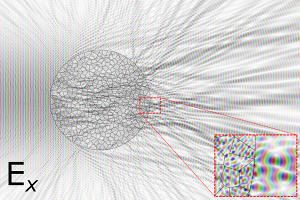 Biological samples, often the subject of optical microscopy, tend to be rather heterogeneous. This affects the propagation of the electromagnetic field of light. While the Maxwell’s laws underlying the propagation of electromagnetic waves in such tissue are well-understood; accurate numerical calculation does not scale well. Even the sub-millimeter-sized sample areas in microscopy pose significant challenges. Recently this changed. Osnabrugge et al. proposed a modification to the efficient Born series that is guaranteed to converge for Helmholtz problems. We have now extended this to solve Maxwell’s equations. The algorithm works for both isotropic and anisotropic dielectric materials, including those with chiral and magnetic properties. Our paper is available on doi:10.1364/OE.27.011946 (open access). The algorithm is made available as a Python library:
Biological samples, often the subject of optical microscopy, tend to be rather heterogeneous. This affects the propagation of the electromagnetic field of light. While the Maxwell’s laws underlying the propagation of electromagnetic waves in such tissue are well-understood; accurate numerical calculation does not scale well. Even the sub-millimeter-sized sample areas in microscopy pose significant challenges. Recently this changed. Osnabrugge et al. proposed a modification to the efficient Born series that is guaranteed to converge for Helmholtz problems. We have now extended this to solve Maxwell’s equations. The algorithm works for both isotropic and anisotropic dielectric materials, including those with chiral and magnetic properties. Our paper is available on doi:10.1364/OE.27.011946 (open access). The algorithm is made available as a Python library: pip install macromax, documentation and the MacroMax source code with examples can be found on GitHub.